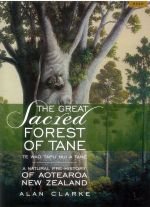BOOK REVIEWS
By Alan Clarke Reviewed by Sue Scheele I was excited to hear of the
publication of a new book on
traditional uses of native plants by
early Mäori that promised extensive
coverage on all aspects. The best
references currently available are
Andrew Crowe’s book on native
edible plants and Murdoch Riley’s
huge resource on medicinal plants.
There is certainly room for another The publishers’ notes refer to a 30 year labour of love and that is evident. Clarke has read and researched widely and the book contains an extensive bibliography, with all important statements referenced, and topics indexed. As someone who has also delved into the early literature on the subject, I fully appreciate the complexities of the task Clarke has taken on. But I was left feeling frustrated. This massive work which is sound at heart is let down by seemingly non-existent editing. Was there a rush to finally get it into print? It is as if sections have been drafted over the years (as you’d expect), but then cobbled together without checking, reviewing, redrafting, and integrating into a satisfactory whole. There is too much repetition of material, too many mistakes, and too many convoluted sentences that make the going harder than it ought. There is an introduction, plus four introductory chapters before the compendium of plant uses that Clarke states is the aim of the book (p. 12). It is valuable to set the scene, explain the nature of the early New Zealand landscape, and describe how the first arrivals dealt with their new environment. But a lot of information gets repeated in these first chapters (150 pages) and it gets rather confusing to follow. Too often Clarke loses his focus. For instance, in a book that aims to concentrate on plants, there is unnecessary detail on birds such as kiwi and moa (Chapter 1). It’s hard to avoid the thought that Clarke is telling us what he has discovered about New Zealand’s prehistory (which is a lot), rather than keeping a clear focus on the stated intention of the book. There is a sense that Clarke is not quite on top of his material, especially in his descriptions of the botany and ecology of early New Zealand. A close reading though, suggests that Clarke does ‘know the answer’ – but because of poor review and editing, statements creep through that are inconsistent, inaccurate or just somewhat off the point. The chapters on medicinal plants, though full of interesting information, are not well defined. It’s hard to know what to find where, with confusing headings such as ‘Post-contact Mäori medicinal plant usage’ and ‘Later post-contact Mäori medicine’. For instance, Chapter 14 is entitled ‘Botanists’ records of medicinal plant uses’. Yet the information in it comes from a variety of sources – including early missionaries, surveyors, naturalists and doctors. The whole section on rongoa (traditional healing focused on the preparation and use of plants) could have been much better laid out, with some of the chapters combined. I would question some of Clarke’s
more general assertions, though in
fairness, much can still be debated.
For instance, I would not support
the “hit and miss” theory of finding
out how to process foods to make
them palatable, or remove toxins.
As Helen Leach has pointed out,
Mäori brought a myriad of food
processing techniques with them
from their Polynesian homeland.
So I suggest few people need have
died eating karaka kernels, before
steaming and soaking methods
were adopted to detoxify them, A strength of the book is Clarke’s understanding of te reo Mäori and Mäori culture. He is authoritative and comfortable when it comes to the important sections on mythology and the spiritual relationship of Mäori to the natural world. In the concluding chapter, he makes a valid contribution to the ongoing debate on tino rangatiratanga, and Mäori control and access to natural resources. The type face is pleasant, and the black and white drawings are attractive, though the placing of them has not been well checked. For example, in the section on forest crops, we see an image of ‘Mäori weapons’ (p. 163), and the image of ‘Mäori and cloak’ on p. 158 would surely be better placed in the chapter on fibre-yielding plants. Is it a worthwhile buy? Guardedly,
yes. There is a lot of good stuff
in this handsome volume, a lot of
detail, and being so well referenced,
there is opportunity for a reader to
|
Home | Journal
| Newsletter | Conferences
Awards | Join
RNZIH | RNZIH Directory | Links
© 2000–2026 Royal New Zealand Institute of Horticulture
Last updated: March 1, 2021


 The Great Sacred Forest of Tane:
The Great Sacred Forest of Tane: